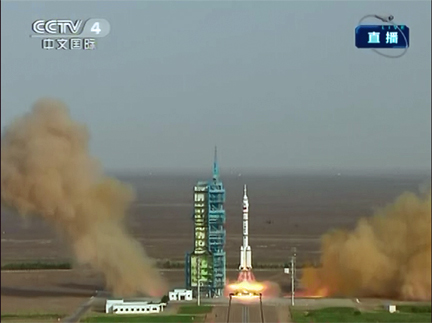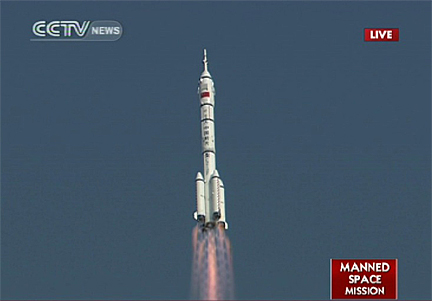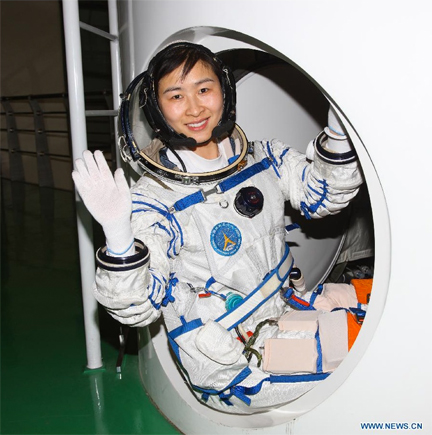China launches manned mission to dock with prototype station module
06/16/2012 07:43 AM Filed in: Space News | China
By WILLIAM HARWOOD
CBS News
A Chinese Shenzhou spacecraft carrying a space veteran and two rookies, including China's first female "taikonaut," rocketed into orbit Saturday on a mission to dock with a prototype space station module, an incremental but critical step on the road to building a Mir-class space station later this decade.
Broadcast live on Chinese television, the Long March-2F rocket carrying the three-seat Shenzhou 9 spacecraft roared to life on time and quickly climbed away from the Jiuquan Satellite Launch Center in north central China at 6:37 p.m. local time (GMT+8; 6:37 a.m. EDT), arcing to the east through a cloudless blue sky.
The mission commander is 46-year-old Jing Haipeng, veteran of China's third and most recent manned mission in 2008 and the first Chinese astronaut to make a return trip to space. His crewmates are both making their first flight: Liu Wang, 43, and Liu Yang, 33, the first female Chinese astronaut. She is an air force major in the People's LIberation Army with 1,680 hours of flying time.
Live television from the spacecraft during the climb to space showed Jing, strapped into the capsule's center seat, with Liu Wang seated to his right and Liu Yang to his left. All three appeared relaxed and in good spirits as they monitored cockpit displays, occasionally waving at the camera.
"I am grateful to the motherland and the people," Liu Yang told reporters during a pre-flight news conference. "I feel honored to fly into space on behalf of hundreds of millions of female Chinese citizens."
Along with achieving the technical goals of the mission, "I want to experience the fantastic environment in space and appreciate the beauty of Earth and our homeland," she said in a report from the Xinhua news agency. "I will live up to your expectations and work with my teammates to complete this space mission."
Joan Johnson-Freese, an expert on China's space program, said Liu Yang's selection "will play well domestically. They're always quoting that Mao said women hold up half of heaven. So this is a big nod to half of 1.3 billion people. It plays well domestically and internationally."
The goal of China's fourth manned space mission is to carry out the first manned rendezvous and docking with the orbiting Tiangong 1 module, a prototype of the much larger laboratory components that will be assembled into an operational space station by the end of the decade, a program that was approved by China's leadership in 1992.
Following a deliberate, step-by-step approach to that long-term goal, China became the third nation, after the United States and the Soviet Union/Russia, to launch a manned spacecraft in October 2003 when Yang Liwei blasted off aboard the Shenzhou 5 spacecraft. Shenzhou 6, carrying two crew members, was successfully launched in October 2005 and Shenzhou 7, carrying a three-man crew -- including Jing Haipeng -- flew in September 2008.
The Tiangong 1 -- "Heavenly Palace" -- research module was launched Sept. 29, 2011, to serve as a target for unmanned and then manned docking missions. One month after Tiangong 1 reached orbit, China launched the unmanned Shenzhou 8 spacecraft, which carried out an automated rendezvous and televised docking with the research module two days later.
"Currently, China is still experimenting with docking technology, which is critical to its ability to transfer people and material from the ground to a long-term outpost in space," wrote Gregory Kulacki in a background paper distributed by the Union of Concerned Scientists.
"Docking requires careful and accurate control of the space capsule to allow it to rendezvous with and attach itself to a port on the station. Experience with docking will also allow China to gain valuable information and experience needed for the design and construction of the space station, which will be assembled from a series of large modules joined together with a similar docking mechanism."
The Shenzhou 9 mission "is designed to test the ability to conduct a piloted docking between a Shenzhou capsule occupied by three Chinese astronauts and the same Tiangong 1 experimental space laboratory," Kulacki wrote. "If all goes well there are plans for a third docking mission between a piloted Shenzhou spacecraft and the Tiangong 1 laboratory in 2013."
The solar-powered Tiangong 1 measures 34 feet long, 11 feet wide and weighs about 8.5 tons. It features a pressurized experiment module where visiting crews can live and work and a "resource module" housing electrical power, propulsion and life support systems.
The space station the Chinese hope to build later this decade will consist of four or more modules linked together with a total mass between 60 and 80 tons.
For comparison, the International Space Station operated by the United States, Russia, Europe, Canada and Japan, is the size of a football field, weighs more than 450 tons and has a multi-module pressurized volume comparable to a 747 jumbo jet. It has been staffed with rotating crews of up to six astronauts and cosmonauts for the past 12 years.
CBS News
A Chinese Shenzhou spacecraft carrying a space veteran and two rookies, including China's first female "taikonaut," rocketed into orbit Saturday on a mission to dock with a prototype space station module, an incremental but critical step on the road to building a Mir-class space station later this decade.
 |
| The Shenzhou 9 spacecraft, perched atop a Long March-2F rocket, climbs away from the Jiuquan Satellite Launch Center in north central China. (Credit: CCTV) |
The mission commander is 46-year-old Jing Haipeng, veteran of China's third and most recent manned mission in 2008 and the first Chinese astronaut to make a return trip to space. His crewmates are both making their first flight: Liu Wang, 43, and Liu Yang, 33, the first female Chinese astronaut. She is an air force major in the People's LIberation Army with 1,680 hours of flying time.
 |
| The Shenzhou 9 spacecraft accelerates toward orbit moments after launch Saturday. (Credit: CCTV) |
"I am grateful to the motherland and the people," Liu Yang told reporters during a pre-flight news conference. "I feel honored to fly into space on behalf of hundreds of millions of female Chinese citizens."
Along with achieving the technical goals of the mission, "I want to experience the fantastic environment in space and appreciate the beauty of Earth and our homeland," she said in a report from the Xinhua news agency. "I will live up to your expectations and work with my teammates to complete this space mission."
Joan Johnson-Freese, an expert on China's space program, said Liu Yang's selection "will play well domestically. They're always quoting that Mao said women hold up half of heaven. So this is a big nod to half of 1.3 billion people. It plays well domestically and internationally."
The goal of China's fourth manned space mission is to carry out the first manned rendezvous and docking with the orbiting Tiangong 1 module, a prototype of the much larger laboratory components that will be assembled into an operational space station by the end of the decade, a program that was approved by China's leadership in 1992.
Following a deliberate, step-by-step approach to that long-term goal, China became the third nation, after the United States and the Soviet Union/Russia, to launch a manned spacecraft in October 2003 when Yang Liwei blasted off aboard the Shenzhou 5 spacecraft. Shenzhou 6, carrying two crew members, was successfully launched in October 2005 and Shenzhou 7, carrying a three-man crew -- including Jing Haipeng -- flew in September 2008.
The Tiangong 1 -- "Heavenly Palace" -- research module was launched Sept. 29, 2011, to serve as a target for unmanned and then manned docking missions. One month after Tiangong 1 reached orbit, China launched the unmanned Shenzhou 8 spacecraft, which carried out an automated rendezvous and televised docking with the research module two days later.
 |
| Liu Yang, China's first female astronaut, waves at the camera during mission training. (Credit: Xinhuanet) |
"Docking requires careful and accurate control of the space capsule to allow it to rendezvous with and attach itself to a port on the station. Experience with docking will also allow China to gain valuable information and experience needed for the design and construction of the space station, which will be assembled from a series of large modules joined together with a similar docking mechanism."
The Shenzhou 9 mission "is designed to test the ability to conduct a piloted docking between a Shenzhou capsule occupied by three Chinese astronauts and the same Tiangong 1 experimental space laboratory," Kulacki wrote. "If all goes well there are plans for a third docking mission between a piloted Shenzhou spacecraft and the Tiangong 1 laboratory in 2013."
The solar-powered Tiangong 1 measures 34 feet long, 11 feet wide and weighs about 8.5 tons. It features a pressurized experiment module where visiting crews can live and work and a "resource module" housing electrical power, propulsion and life support systems.
The space station the Chinese hope to build later this decade will consist of four or more modules linked together with a total mass between 60 and 80 tons.
For comparison, the International Space Station operated by the United States, Russia, Europe, Canada and Japan, is the size of a football field, weighs more than 450 tons and has a multi-module pressurized volume comparable to a 747 jumbo jet. It has been staffed with rotating crews of up to six astronauts and cosmonauts for the past 12 years.